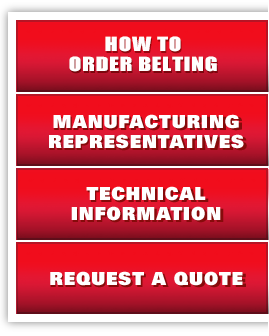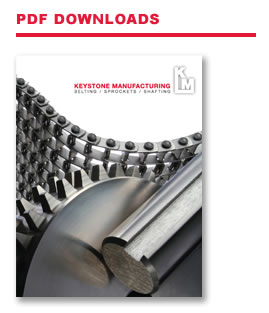Belt Width: The overall distance across a belt, measured from the outside end of a rod on one side of the belt to the outside end of the rod on the opposite side of the belt. Clinched Selvage: Manner of locking the connecting rods where the rod end is looped back through an extra hole on both edges of the belt and bent so that it is parallel with the strip. Drive Sprockets: Found at the discharge end of a conveyor, drive sprockets are under power and should pull the loaded conveyor. Drive sprockets must be keyed to the drive shaft, and are always located in an odd numbered belt opening. Drive Tension (Td): The amount of tension or pull that a belt can handle without leading to premature fatigue of failure. Please refer to the Drive Tension Calculations section for more information. Internal Welds: Resistance welds between every other connecting rod and the flat strip in the 2nd opening from each edge of the belt. On True 1/2" x 1/2" belts, this weld is on every 3rd connecting rod. See our Conveyor Belts section for more information. Lateral Pitch: The distance from the center of one drive opening to the center of the next drive opening (odd numbered openings), measured across the width of the belt. The measurement can vary with the belt width and mesh size. Longitudinal Pitch: The distance from the center of one rod to the center of the next rod. East coast pitch is 1.084 inches. West coast pitch is 1.054 inches. Pitch for True 1/2" x 1/2" mesh is 0.542 inches. Machined Hubs: Sprockets which have had their hubs machined to reduce their overall width. This allows closer spacing of sprockets across the width of the belt in heavy load applications. Openings: Each rectangular open area enclosed by the strip. The number of openings are counted across the width of the conveyor and must always be odd. Selvage: The manner in which the rod end is finished on either edge of a belt. Tail Sprockets: Also known as idle sprockets, they are usually located at the input end of a conveyor and are not under power. Keystone recommends that tail sprockets be left to rotate freely, except the center sprocket which should be keyed to insure tail shaft rotation. Welded Selvage: Manner of locking the connecting rods where the rod end is heated and formed into a button head. |

| Home | Products | Products | Technical Information | Applications | Glossary | Frequently Asked Questions | Contact |

